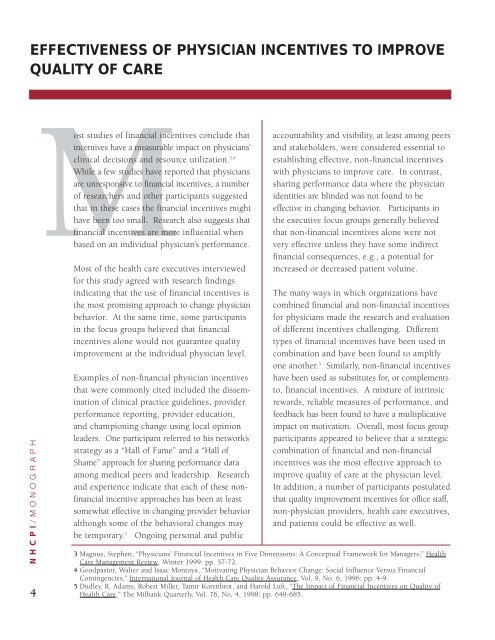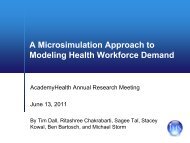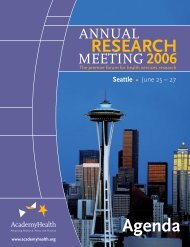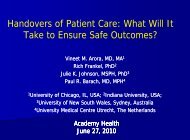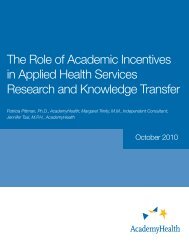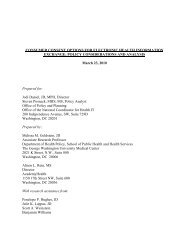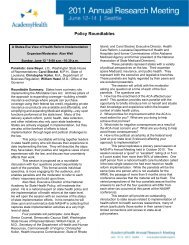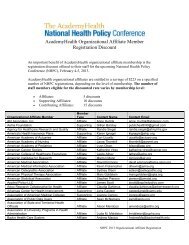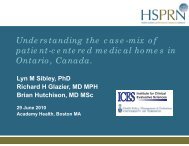The Growing Case for Using Physician Incentives to - AcademyHealth
The Growing Case for Using Physician Incentives to - AcademyHealth
The Growing Case for Using Physician Incentives to - AcademyHealth
You also want an ePaper? Increase the reach of your titles
YUMPU automatically turns print PDFs into web optimized ePapers that Google loves.
EFFECTIVENESS OF PHYSICIAN INCENTIVES TO IMPROVE<br />
QUALITY OF CARE<br />
NHCPI/MONOGRAPH<br />
4<br />
Most studies of financial incentives conclude that<br />
incentives have a measurable impact on physicians’<br />
clinical decisions and resource utilization. 3,4<br />
While a few studies have reported that physicians<br />
are unresponsive <strong>to</strong> financial incentives, a number<br />
of researchers and other participants suggested<br />
that in these cases the financial incentives might<br />
have been <strong>to</strong>o small. Research also suggests that<br />
financial incentives are more influential when<br />
based on an individual physician’s per<strong>for</strong>mance.<br />
Most of the health care executives interviewed<br />
<strong>for</strong> this study agreed with research findings<br />
indicating that the use of financial incentives is<br />
the most promising approach <strong>to</strong> change physician<br />
behavior. At the same time, some participants<br />
in the focus groups believed that financial<br />
incentives alone would not guarantee quality<br />
improvement at the individual physician level.<br />
Examples of non-financial physician incentives<br />
that were commonly cited included the dissemination<br />
of clinical practice guidelines, provider<br />
per<strong>for</strong>mance reporting, provider education,<br />
and championing change using local opinion<br />
leaders. One participant referred <strong>to</strong> his network’s<br />
strategy as a “Hall of Fame” and a “Hall of<br />
Shame” approach <strong>for</strong> sharing per<strong>for</strong>mance data<br />
among medical peers and leadership. Research<br />
and experience indicate that each of these nonfinancial<br />
incentive approaches has been at least<br />
somewhat effective in changing provider behavior<br />
although some of the behavioral changes may<br />
be temporary. 3 Ongoing personal and public<br />
accountability and visibility, at least among peers<br />
and stakeholders, were considered essential <strong>to</strong><br />
establishing effective, non-financial incentives<br />
with physicians <strong>to</strong> improve care. In contrast,<br />
sharing per<strong>for</strong>mance data where the physician<br />
identities are blinded was not found <strong>to</strong> be<br />
effective in changing behavior. Participants in<br />
the executive focus groups generally believed<br />
that non-financial incentives alone were not<br />
very effective unless they have some indirect<br />
financial consequences, e.g., a potential <strong>for</strong><br />
increased or decreased patient volume.<br />
<strong>The</strong> many ways in which organizations have<br />
combined financial and non-financial incentives<br />
<strong>for</strong> physicians made the research and evaluation<br />
of different incentives challenging. Different<br />
types of financial incentives have been used in<br />
combination and have been found <strong>to</strong> amplify<br />
one another. 5 Similarly, non-financial incentives<br />
have been used as substitutes <strong>for</strong>, or complements<br />
<strong>to</strong>, financial incentives. A mixture of intrinsic<br />
rewards, reliable measures of per<strong>for</strong>mance, and<br />
feedback has been found <strong>to</strong> have a multiplicative<br />
impact on motivation. Overall, most focus group<br />
participants appeared <strong>to</strong> believe that a strategic<br />
combination of financial and non-financial<br />
incentives was the most effective approach <strong>to</strong><br />
improve quality of care at the physician level.<br />
In addition, a number of participants postulated<br />
that quality improvement incentives <strong>for</strong> office staff,<br />
non-physician providers, health care executives,<br />
and patients could be effective as well.<br />
3 Magnus, Stephen, “<strong>Physician</strong>s’ Financial <strong>Incentives</strong> in Five Dimensions: A Conceptual Framework <strong>for</strong> Managers,” Health<br />
Care Management Review, Winter 1999: pp. 57-72.<br />
4 Goodpas<strong>to</strong>r, Walter and Isaac Mon<strong>to</strong>ya, “Motivating <strong>Physician</strong> Behavior Change: Social Influence Versus Financial<br />
Contingencies,” International Journal of Health Care Quality Assurance, Vol. 9, No. 6, 1996: pp. 4-9.<br />
5 Dudley, R. Adams, Robert Miller, Tamir Korenbrot, and Harold Luft, “<strong>The</strong> Impact of Financial <strong>Incentives</strong> on Quality of<br />
Health Care,” <strong>The</strong> Milbank Quarterly, Vol. 76, No. 4, 1998: pp. 649-685.


